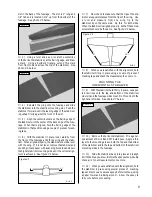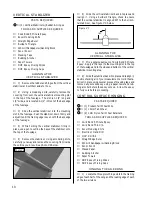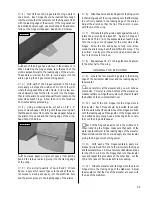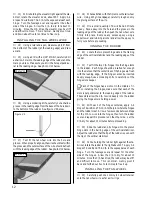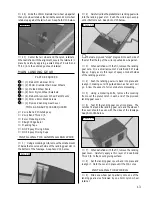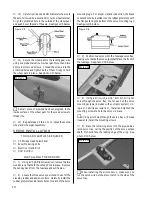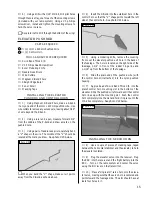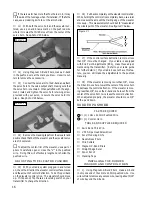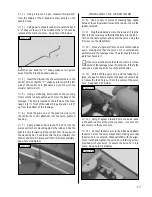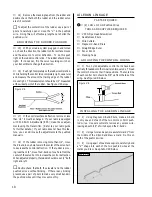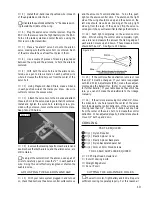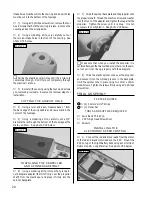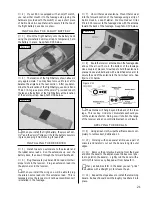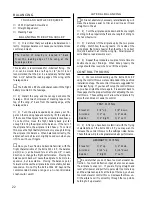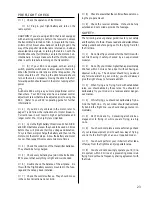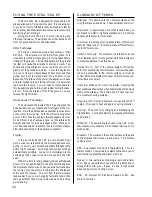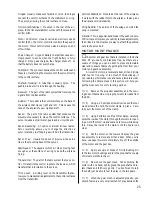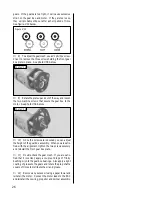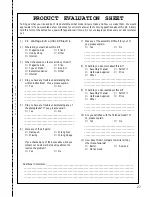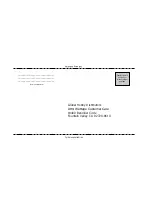
23
❑
1) Check the operation of the throttle.
❑
A) Plug in your flight battery and turn on the
radio system.
CAUTION
If you are using an ESC that is not equipped
with an arming switch, do not turn the receiver on unless
the transmitter is turned on first. Always turn the trans-
mitter on first. Never allow hands or clothing to get in the
way of the propeller when the radio is turned on. Sudden
unwanted radio signals, or turning the radio on with the
throttle stick set at full throttle, can turn the motor on un-
intentionally. Always make sure that the throttle control
stick is set to idle before turning on the transmitter.
❑
B) If your ESC is equipped with an arming
switch, press the switch once to allow power to the motor.
When the throttle control stick is at the idle position, the
motor should be off. Moving the stick forward should
turn on the motor. Gradually moving the stick to the full
forward position should result in the motor running at full
power.
☛
Some ESCs will give you more proportional control
than others. Your ESC may also have a manual control
adjustment screw that must be adjusted prior to using the
ESC. (Refer to your ESC's operating guide for further
information.)
❑
2) If you did not yet break in the motor, refer to
page # 7 and follow the instructions for motor break-in.
Correct break-in will result in higher performance and
longer motor life.
It is highly recommended.
❑
3) Cycle the flight battery three times. When NiCD
and NiMH batteries are new they need to be used 2-3 times
before they will produce their top voltage and duration.
To cycle them, simply charge the battery and then run the
motor until the motor stops. Allow the battery and motor
to cool, then repeat this procedure two more times.
❑
4) Check the condition of the transmitter batteries.
They should be fully charged.
❑
5) Check every bolt and glue joint in the Extra 330L
EP to ensure that everything is tight and well-bonded.
❑
6) Double check the balance of the airplane. Do
this with the flight battery securely mounted in the fuse-
lage and the canopy deck installed.
❑
7) Check the control surfaces. They should move
in the correct direction and not bind.
PREFLIGHT CHECK
❑
8) Check to ensure that the control surfaces are mov-
ing the proper amount.
❑
9) Check the receiver antenna. It should be fully
extended and not coiled up inside the fuselage.
SAFETY
The following are our general guidelines for your safety
and the safety of others. Please read and understand these
safety guidelines before going out to the flying field for
the first time.
❑
1) Do not test fly your model for the first time with-
out first having it safety-checked by an experienced
modeler.
❑
2) Do not fly your model higher than approximately
400 feet within 3 miles of an airport without having an
observer with you. The observer should tell you about
any full size aircraft in your vicinity; you should always
give the right of way to full scale aircraft.
❑
3) When flying at a flying field with established
rules, you should abide by those rules. You should not
deliberately fly your model in a reckless and/or danger-
ous manner.
❑
4) While flying, you should not deliberately fly be-
hind the flight line. If your model should inadvertently
fly behind the flight line, you should change course im-
mediately.
❑
5) Don't drink and fly. Consuming alcoholic bev-
erages prior to flying, or while you are flying, is a big
no-no.
❑
6) You should complete a successful range check
of your radio equipment prior to each new day of flying,
or prior to the first flight of a new or repaired model.
❑
7) You should perform your initial turn after take-
off away from the flightline and/or spectator area.
❑
8) You should not knowingly operate your R/C ra-
dio system within 3 miles of a preexisting model club
flying field without a frequency sharing agreement with
that club.

